
Leroy Golf Sumerian Antiquities
G-Sum 1: Statuette of a Deified King

 Although
pottery statuettes are fairly common those in stone are very scarce and seldom
found. When found they are often in hordes from temple sites dating over a considerable
period. They were supposed to remain in the sacred presence of the temple cult
statue to remind the god (or goddess) to answer the donor’s request. As
they were too sacred to throw out, when they multiplied too much or were outdated
they were often built into the floor or walls of temple buildings. Some of the
smaller statues were for placement in home altars of the wealthy, but those
are usually not well carved or were of pottery.
Although
pottery statuettes are fairly common those in stone are very scarce and seldom
found. When found they are often in hordes from temple sites dating over a considerable
period. They were supposed to remain in the sacred presence of the temple cult
statue to remind the god (or goddess) to answer the donor’s request. As
they were too sacred to throw out, when they multiplied too much or were outdated
they were often built into the floor or walls of temple buildings. Some of the
smaller statues were for placement in home altars of the wealthy, but those
are usually not well carved or were of pottery.
This statue is in reddish veined gypsum with a dedication inscription
in a panel on the back and a donator’s name lightly engraved on the upper
right arm. It portrays a deified king with single horned head dress carrying
a libation cup in his right hand. The back of the hair shows a row of drilled
holes depicting the end of the curls, and this is often a mark of being from
Mari, that most distant of Sumerian cities on the upper Euphrates. As this statue
is stylistically of a family with the others, and drilled work was also very
common in the Jemdat Nasr period, it would seem to be of southern origin. Static,
restrained stone work style typical of Ur III and the Late Dynastic Period into
the Old Babylonian. Early Old Babylonian Period, c. 1800 B.C., 152 mm tall.
In a private collection.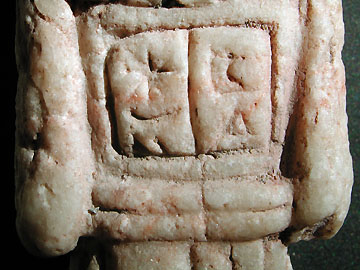
G-Sum 2: Statuette of a Goddess or Devotee
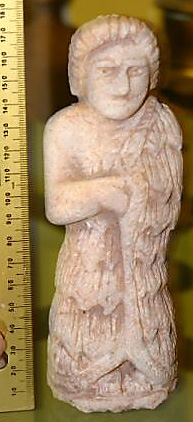
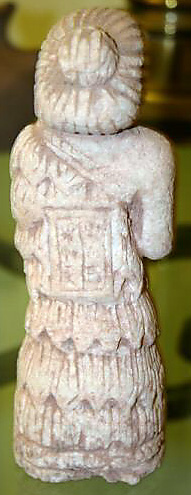 A
gypsum statue of a standing Sumerian goddess or worshipper, with elaborate wrapped
hair. There is an inscribed rectangular panel on the back. As with G-Sum 1 this
is almost certainly a votive statue to be placed in the presence of the temple
deity statue. The dress worn off the right shoulder is typical of early Sumerian
clothing, as is the layered effect which may show derivation from pieced animal
skins. late Sumerian Dynastic Period or early Old Babylonian, c. 2100-1800 B.C.
176 mm tall.
A
gypsum statue of a standing Sumerian goddess or worshipper, with elaborate wrapped
hair. There is an inscribed rectangular panel on the back. As with G-Sum 1 this
is almost certainly a votive statue to be placed in the presence of the temple
deity statue. The dress worn off the right shoulder is typical of early Sumerian
clothing, as is the layered effect which may show derivation from pieced animal
skins. late Sumerian Dynastic Period or early Old Babylonian, c. 2100-1800 B.C.
176 mm tall.
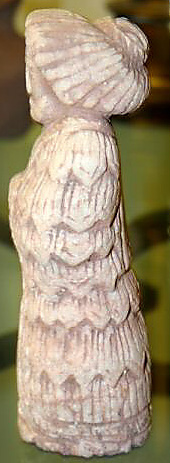
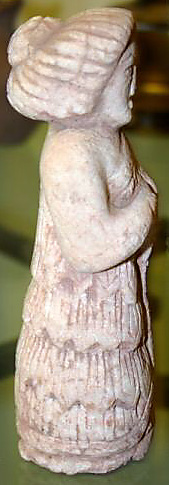
G-Sum 3: Seated Statuette of a Goddess
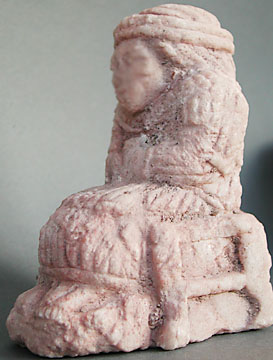 A
Sumerian goddess, likely Inanna, seated on a throne-like chair. There is a blank
rectangular panel on the back that was intended to receive an inscription. Several
of the carvings and cylinder seals from the Golf Collection have inscriptions
to Inanna and may have come from a temple site of Innana. Inanna was the city
goddess of Uruk, and her father Nanna was the city god of Ur, so we would expect
to find her well represented in southern Sumeria. A well known type of statue.
Gypsum, with chipping to face and base, with soil and salt encrustation to lower
areas. Sumerian Dynastic Period, 2300-2000 B.C. 87 mm tall x 61 mm x 46 mm.
A
Sumerian goddess, likely Inanna, seated on a throne-like chair. There is a blank
rectangular panel on the back that was intended to receive an inscription. Several
of the carvings and cylinder seals from the Golf Collection have inscriptions
to Inanna and may have come from a temple site of Innana. Inanna was the city
goddess of Uruk, and her father Nanna was the city god of Ur, so we would expect
to find her well represented in southern Sumeria. A well known type of statue.
Gypsum, with chipping to face and base, with soil and salt encrustation to lower
areas. Sumerian Dynastic Period, 2300-2000 B.C. 87 mm tall x 61 mm x 46 mm.
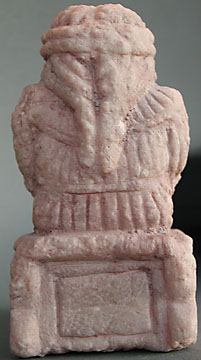
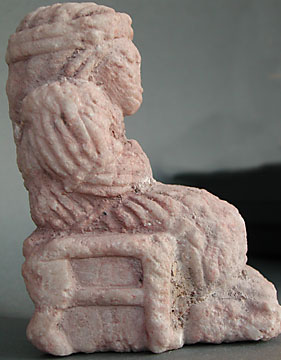
G-Sum 4: Statuette of a Priestess or Goddess with Inscribed
Skirt
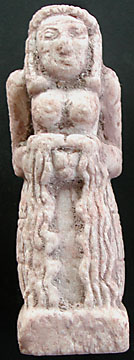
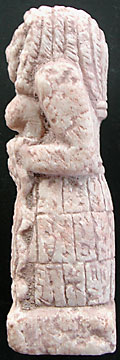 A
Gypsum statuette of a priestess or goddess from the Sumerian Dynastic period,
most likely Inanna. Her skirt bears a 28 register inscription in linear cuneiform,
much worn on some panels, that may date and explain this entire group of statues.
She holds a sacred vessel from which the life-giving waters flow in two streams.
Several gods and goddesses are shown thus with running water, including Inanna,
and it speaks of their life-giving powers as only water brings life to the barren
earth of Sumeria. The two streams of water are thought to stand for the Euphrates
and Tigris rivers. This is the earliest of the group of statues and dates to
c. 2600-2300 B.C. 150 mm tall.
A
Gypsum statuette of a priestess or goddess from the Sumerian Dynastic period,
most likely Inanna. Her skirt bears a 28 register inscription in linear cuneiform,
much worn on some panels, that may date and explain this entire group of statues.
She holds a sacred vessel from which the life-giving waters flow in two streams.
Several gods and goddesses are shown thus with running water, including Inanna,
and it speaks of their life-giving powers as only water brings life to the barren
earth of Sumeria. The two streams of water are thought to stand for the Euphrates
and Tigris rivers. This is the earliest of the group of statues and dates to
c. 2600-2300 B.C. 150 mm tall.
Her arms are stylistically similar to those of the god in G-Sum
1 which helps to connect the statues to the same site. In this statue the modeling
looser and has more personality. The breasts are well shaped and detailed, the
hair and water both flow with some life, and her eyes seem to look at you. The
crooked mouth is distinctive and must be of some particular significance, perhaps
the fierce reputation of Inanna when angry. Her hair is of a very early type
and is close to that on the famous Khafaje statue of a bare breasted worhipper
of the Jemdat Nasr period, as is much else of this statue. The biggest difference
is the large nose of the Khafaje statue, but all of the Golf statues have broken
noses, either from the accidents of age or the well known Muslim habit of breaking
of noses on statues to fight idol worship. Even the Egyptian Sphinx was relatively
intact until early Muslims heavily damaged the face in their religious zeal.
To see the inscription on her skirt see the details
page.
G-Sum 5: Toso of a Summerian Worshipper
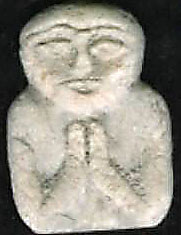
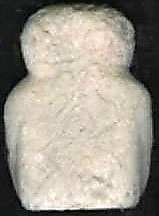 A
limestone carving of the torso of a Sumerian with hands crossed over the chest
in supplication and worship. The seeming bald head could indicate a priest.
These little statues were intended to be placed before the temple statue of
the god or goddess to make constant prayers for the worshipper’s well
being.
A
limestone carving of the torso of a Sumerian with hands crossed over the chest
in supplication and worship. The seeming bald head could indicate a priest.
These little statues were intended to be placed before the temple statue of
the god or goddess to make constant prayers for the worshipper’s well
being.
The simple, primitive oratory attitude of the figure and the large, full head
and prominent eyes shows a close relationship to the Tell Brak figures, although
it is likely more cultural borrowing and similar, primitive art styles that
connect them, as this torso seems early Sumerian in style.
Uruk or Jemdat Nasr Period, 3500-2900 B.C. 72 mm x 51 mm x 22 mm. In a private
collection.
G-Sum 6: Stone Boat
 A
steatite votive boat with an very worn, boxed inscription on the side. This
is a wide river boat like the later Mesopotamian freight boats and quite unlike
the more delicate, elongated marsh boats of the lower delta. Similar boats appear
on many Sumerian and Babylonian sculptured panels. These boat carvings both
represent the real boats of daily commerce and fishing in this watery land,
and the divine boats of the Gods. Note should be made of the construction with
wide planks in caraval fashion. That implies that this was modeled on a large
and sturdy sea-going vessel.
A
steatite votive boat with an very worn, boxed inscription on the side. This
is a wide river boat like the later Mesopotamian freight boats and quite unlike
the more delicate, elongated marsh boats of the lower delta. Similar boats appear
on many Sumerian and Babylonian sculptured panels. These boat carvings both
represent the real boats of daily commerce and fishing in this watery land,
and the divine boats of the Gods. Note should be made of the construction with
wide planks in caraval fashion. That implies that this was modeled on a large
and sturdy sea-going vessel.
This votive boat with its solid structure may well be related
to the Dilmun seal of the Akkadian Period scribe-merchant shown on the Sumerian
seals page. Overseas trade would have been in big boats like this, and Sumerian
mythology frequently mentions the “Dilmun” and “Magan”
boats, both coming and going and being lost at sea.
In going to the land of the Gods to seek eternal life, the semi-divine
hero Gilgamish needed to travel in the boat of Urshanabi, boatman of the Gods.
To touch the surrounding waters was death. This also likely relates to Chaeron
and his boat for crossing the river Styx to the Land of the Dead in ancient
Greece, and to the funerary boats of ancient Egypt. Boats were magical vehicles
for entering the spiritual world around the world and especially in Sumeria,
the land of rivers and marshes. Sumerian Dynastic Period, 2500-1900 B.C. 112
mm long x 41 mm wide x 36 mm tall. In a private collection.
G-Sum 7: Votive Steatite Cup
 A
small votive cup in cream steatite mottled with black and brown such as were
used in temples to pour librations and offerings to the gods. The temple statues
of the gods were “fed” several times a day to gain their pleasure,
and temples had both drainage systems to remove the ‘used’ libations
and ovens to cook offerings. (This is the type of offering cup being held by
the statue No. G-Sum 1 above.) The richly mottled and veined steatite used in
this cup is paralleled in Dynastic seals, but starting with the Akkadian period
seals are mostly plain, black steatite or haematite. Only in Syria do we find
the continued use of richly colored stone down to the Classical Period. A modern
parallel is the replacement of the elaborately colored men’s clothing
of the Renaissance by the 18th century with dull monotonous black as is still
seen in modern men’s suits. In both cases this likely reflects a social
change from new, proud nobility to a rigid bureaucratic system. Sumerian Dynastic
Period 2500-1900 B.C. 59 mm wide x 28 mm tall.
A
small votive cup in cream steatite mottled with black and brown such as were
used in temples to pour librations and offerings to the gods. The temple statues
of the gods were “fed” several times a day to gain their pleasure,
and temples had both drainage systems to remove the ‘used’ libations
and ovens to cook offerings. (This is the type of offering cup being held by
the statue No. G-Sum 1 above.) The richly mottled and veined steatite used in
this cup is paralleled in Dynastic seals, but starting with the Akkadian period
seals are mostly plain, black steatite or haematite. Only in Syria do we find
the continued use of richly colored stone down to the Classical Period. A modern
parallel is the replacement of the elaborately colored men’s clothing
of the Renaissance by the 18th century with dull monotonous black as is still
seen in modern men’s suits. In both cases this likely reflects a social
change from new, proud nobility to a rigid bureaucratic system. Sumerian Dynastic
Period 2500-1900 B.C. 59 mm wide x 28 mm tall.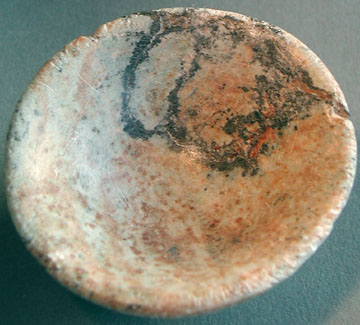
G-Sum 8a and 8b: Two Sumerian Necklaces (restrung)
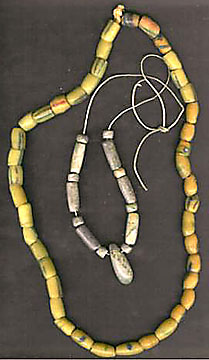 Two
stone bead necklaces: 8A with yellowish tube beads and 8b with cylinder seal-like
beads and a larger center ornament. Location unknown.
Two
stone bead necklaces: 8A with yellowish tube beads and 8b with cylinder seal-like
beads and a larger center ornament. Location unknown.
Leroy Golf Sumerian Seals
Golf Artifact Details
Leroy Golf Collection Home
Antiques AtoZ Home


 Although
pottery statuettes are fairly common those in stone are very scarce and seldom
found. When found they are often in hordes from temple sites dating over a considerable
period. They were supposed to remain in the sacred presence of the temple cult
statue to remind the god (or goddess) to answer the donor’s request. As
they were too sacred to throw out, when they multiplied too much or were outdated
they were often built into the floor or walls of temple buildings. Some of the
smaller statues were for placement in home altars of the wealthy, but those
are usually not well carved or were of pottery.
Although
pottery statuettes are fairly common those in stone are very scarce and seldom
found. When found they are often in hordes from temple sites dating over a considerable
period. They were supposed to remain in the sacred presence of the temple cult
statue to remind the god (or goddess) to answer the donor’s request. As
they were too sacred to throw out, when they multiplied too much or were outdated
they were often built into the floor or walls of temple buildings. Some of the
smaller statues were for placement in home altars of the wealthy, but those
are usually not well carved or were of pottery.


 A
gypsum statue of a standing Sumerian goddess or worshipper, with elaborate wrapped
hair. There is an inscribed rectangular panel on the back. As with G-Sum 1 this
is almost certainly a votive statue to be placed in the presence of the temple
deity statue. The dress worn off the right shoulder is typical of early Sumerian
clothing, as is the layered effect which may show derivation from pieced animal
skins. late Sumerian Dynastic Period or early Old Babylonian, c. 2100-1800 B.C.
176 mm tall.
A
gypsum statue of a standing Sumerian goddess or worshipper, with elaborate wrapped
hair. There is an inscribed rectangular panel on the back. As with G-Sum 1 this
is almost certainly a votive statue to be placed in the presence of the temple
deity statue. The dress worn off the right shoulder is typical of early Sumerian
clothing, as is the layered effect which may show derivation from pieced animal
skins. late Sumerian Dynastic Period or early Old Babylonian, c. 2100-1800 B.C.
176 mm tall.

 A
Sumerian goddess, likely Inanna, seated on a throne-like chair. There is a blank
rectangular panel on the back that was intended to receive an inscription. Several
of the carvings and cylinder seals from the Golf Collection have inscriptions
to Inanna and may have come from a temple site of Innana. Inanna was the city
goddess of Uruk, and her father Nanna was the city god of Ur, so we would expect
to find her well represented in southern Sumeria. A well known type of statue.
Gypsum, with chipping to face and base, with soil and salt encrustation to lower
areas. Sumerian Dynastic Period, 2300-2000 B.C. 87 mm tall x 61 mm x 46 mm.
A
Sumerian goddess, likely Inanna, seated on a throne-like chair. There is a blank
rectangular panel on the back that was intended to receive an inscription. Several
of the carvings and cylinder seals from the Golf Collection have inscriptions
to Inanna and may have come from a temple site of Innana. Inanna was the city
goddess of Uruk, and her father Nanna was the city god of Ur, so we would expect
to find her well represented in southern Sumeria. A well known type of statue.
Gypsum, with chipping to face and base, with soil and salt encrustation to lower
areas. Sumerian Dynastic Period, 2300-2000 B.C. 87 mm tall x 61 mm x 46 mm.


 A
Gypsum statuette of a priestess or goddess from the Sumerian Dynastic period,
most likely Inanna. Her skirt bears a 28 register inscription in linear cuneiform,
much worn on some panels, that may date and explain this entire group of statues.
She holds a sacred vessel from which the life-giving waters flow in two streams.
Several gods and goddesses are shown thus with running water, including Inanna,
and it speaks of their life-giving powers as only water brings life to the barren
earth of Sumeria. The two streams of water are thought to stand for the Euphrates
and Tigris rivers. This is the earliest of the group of statues and dates to
c. 2600-2300 B.C. 150 mm tall.
A
Gypsum statuette of a priestess or goddess from the Sumerian Dynastic period,
most likely Inanna. Her skirt bears a 28 register inscription in linear cuneiform,
much worn on some panels, that may date and explain this entire group of statues.
She holds a sacred vessel from which the life-giving waters flow in two streams.
Several gods and goddesses are shown thus with running water, including Inanna,
and it speaks of their life-giving powers as only water brings life to the barren
earth of Sumeria. The two streams of water are thought to stand for the Euphrates
and Tigris rivers. This is the earliest of the group of statues and dates to
c. 2600-2300 B.C. 150 mm tall.
 A
limestone carving of the torso of a Sumerian with hands crossed over the chest
in supplication and worship. The seeming bald head could indicate a priest.
These little statues were intended to be placed before the temple statue of
the god or goddess to make constant prayers for the worshipper’s well
being.
A
limestone carving of the torso of a Sumerian with hands crossed over the chest
in supplication and worship. The seeming bald head could indicate a priest.
These little statues were intended to be placed before the temple statue of
the god or goddess to make constant prayers for the worshipper’s well
being.  A
steatite votive boat with an very worn, boxed inscription on the side. This
is a wide river boat like the later Mesopotamian freight boats and quite unlike
the more delicate, elongated marsh boats of the lower delta. Similar boats appear
on many Sumerian and Babylonian sculptured panels. These boat carvings both
represent the real boats of daily commerce and fishing in this watery land,
and the divine boats of the Gods. Note should be made of the construction with
wide planks in caraval fashion. That implies that this was modeled on a large
and sturdy sea-going vessel.
A
steatite votive boat with an very worn, boxed inscription on the side. This
is a wide river boat like the later Mesopotamian freight boats and quite unlike
the more delicate, elongated marsh boats of the lower delta. Similar boats appear
on many Sumerian and Babylonian sculptured panels. These boat carvings both
represent the real boats of daily commerce and fishing in this watery land,
and the divine boats of the Gods. Note should be made of the construction with
wide planks in caraval fashion. That implies that this was modeled on a large
and sturdy sea-going vessel. A
small votive cup in cream steatite mottled with black and brown such as were
used in temples to pour librations and offerings to the gods. The temple statues
of the gods were “fed” several times a day to gain their pleasure,
and temples had both drainage systems to remove the ‘used’ libations
and ovens to cook offerings. (This is the type of offering cup being held by
the statue No. G-Sum 1 above.) The richly mottled and veined steatite used in
this cup is paralleled in Dynastic seals, but starting with the Akkadian period
seals are mostly plain, black steatite or haematite. Only in Syria do we find
the continued use of richly colored stone down to the Classical Period. A modern
parallel is the replacement of the elaborately colored men’s clothing
of the Renaissance by the 18th century with dull monotonous black as is still
seen in modern men’s suits. In both cases this likely reflects a social
change from new, proud nobility to a rigid bureaucratic system. Sumerian Dynastic
Period 2500-1900 B.C. 59 mm wide x 28 mm tall.
A
small votive cup in cream steatite mottled with black and brown such as were
used in temples to pour librations and offerings to the gods. The temple statues
of the gods were “fed” several times a day to gain their pleasure,
and temples had both drainage systems to remove the ‘used’ libations
and ovens to cook offerings. (This is the type of offering cup being held by
the statue No. G-Sum 1 above.) The richly mottled and veined steatite used in
this cup is paralleled in Dynastic seals, but starting with the Akkadian period
seals are mostly plain, black steatite or haematite. Only in Syria do we find
the continued use of richly colored stone down to the Classical Period. A modern
parallel is the replacement of the elaborately colored men’s clothing
of the Renaissance by the 18th century with dull monotonous black as is still
seen in modern men’s suits. In both cases this likely reflects a social
change from new, proud nobility to a rigid bureaucratic system. Sumerian Dynastic
Period 2500-1900 B.C. 59 mm wide x 28 mm tall.
 Two
stone bead necklaces: 8A with yellowish tube beads and 8b with cylinder seal-like
beads and a larger center ornament. Location unknown.
Two
stone bead necklaces: 8A with yellowish tube beads and 8b with cylinder seal-like
beads and a larger center ornament. Location unknown.